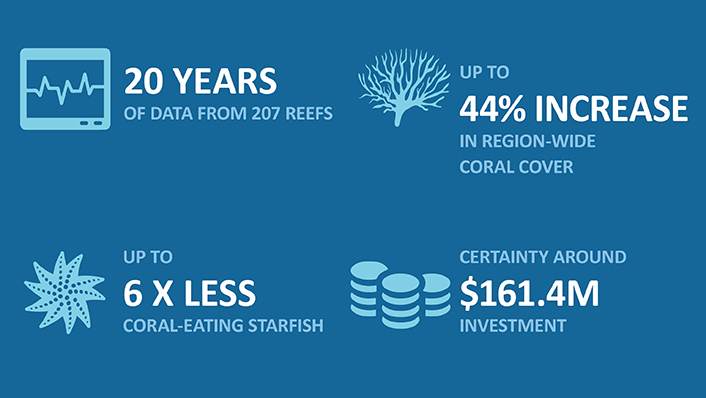The challenge
Crown-of-thorns starfish (also known as COTS) are a major driver of coral loss throughout the Indo Pacific, including the Great Barrier Reef. The native starfish eat living hard coral and when in large numbers, can decimate reef-building coral communities. Four waves of starfish outbreaks have been recorded on the Great Barrier Reef since the 1960s.
Manual culling is one management action to reduce starfish numbers and protect coral. On the Great Barrier Reef, this activity is implemented through the collaborative COTS Control Program.
The Control Program originally targeted small-scale, high-value tourism sites during the third outbreak (1992-2009) on the Reef. From 2012, during the fourth outbreak, the Program evolved with a strategic ‘scaled up’ approach to suppress starfish numbers and protect coral at the regional level.
A robust assessment of Control Program performance required an extensive region-wide data set across many reefs from before and after the Program’s renewed activities commenced.
The approach
AIMS’ Long-Term Monitoring Program (LTMP), begun in 1986, routinely monitors the condition and status of reefs along the length and breadth of the Great Barrier Reef. It is the most comprehensive and extensive record of a reef ecosystem in the world.
The LTMP records of crown-of-thorns starfish numbers and hard coral cover were the ideal source of data to test the efficacy of the Control Program. The evaluation (Matthews et al, 2024) used 20 years of data from 207 reefs, across seven regions on the Great Barrier Reef, to compare outcomes from the third starfish outbreak wave (before 2012), and the fourth outbreak wave (after 2012 when current strategic control activities commenced). Different levels of control effort and timeliness were also assessed.
The impact
AIMS’ large scale, long term, routine information demonstrated that the improved COTS Control Program was an effective tool to protect corals at regional scales.
Starfish densities in some regions were reduced by up to six times with timely and adequate control efforts compared to the previous outbreak. This level of effort also coincided with region-wide coral cover increases of up to 44% despite other disturbances occurring. The previous outbreak saw coral cover declines of up to 37%. Even reefs which received reduced control effort were afforded some protection from the Control Program. On these reefs, the rate of coral loss was more than halved from the previous outbreak.
The results indicate that the COTS Control Program may contribute to delaying the wave of outbreak progression to adjoining sectors by reducing starfish larval supply.
AIMS’ LTMP was the ideal data source for a spatially extensive and robust evaluation of the Control Program, providing certainty around its efficacy value as a resilience-based management tool. The COTS Control Program is a core priority of the Reef 2050 Plan and supported by a $161.4 million investment (2022 -2030) from the Australian Government.
The COTS Control Program is led by the Great Barrier Reef Marine Park Authority in partnership with the Great Barrier Reef Foundation, Reef and Rainforest Research Centre and supporting government agencies, industry partners and contractors.


